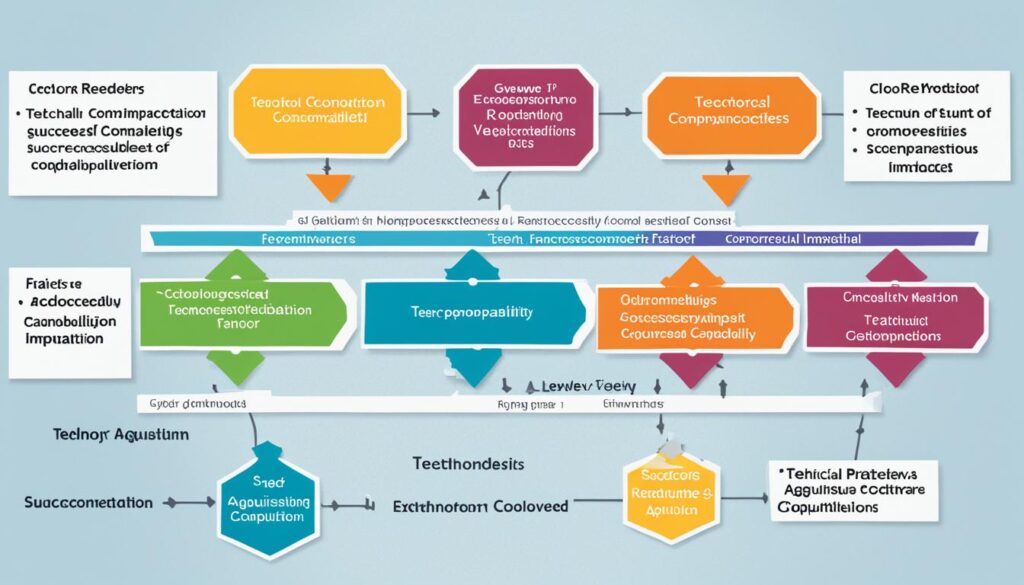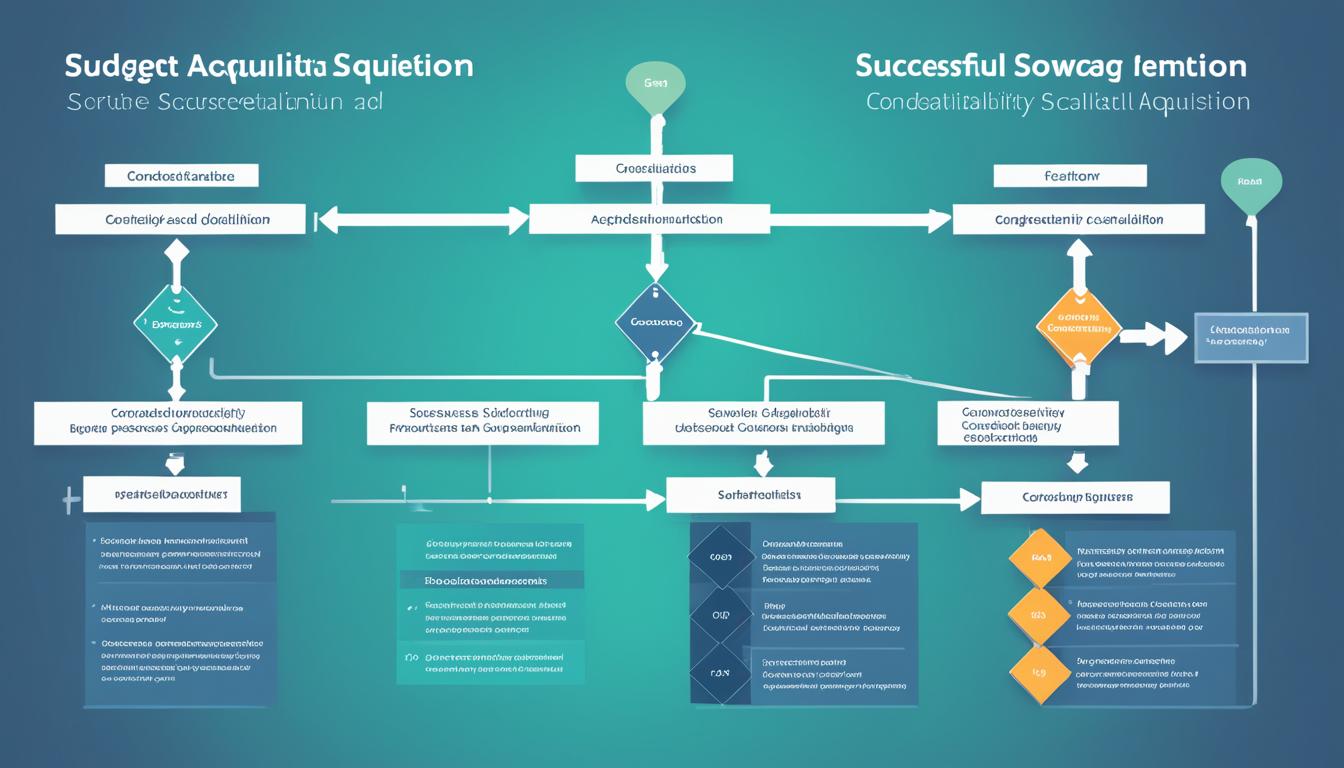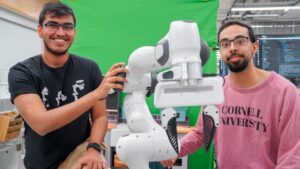Starting the software acquisition journey needs careful thought on what makes it successful. Businesses must use smart strategies and lay strong foundations. This early planning isn’t just a first step. It’s a major part that leads to successful software use and helps meet company goals.
“The Road to Successful ITS Software Acquisition” by Mitretek Systems highlights two important steps. Developing system requirements and choosing the right contract are key. These are done early and shape how software is used in the future.
Key Takeaways
- Effective early planning sets the stage for software acquisition success factors.
- Crucial to determining an acquisition’s success are developing system requirements and selecting an appropriate contracting vehicle.
- Air-tight project plans and agile strategies enhance the chances of successful integration within an organization.
- Ongoing risk management is integral for navigating the software acquisition process.
- Building a cohesive team is pivotal for meeting common software project goals and milestones.
Understanding the Significance of Market Demands in Software Acquisition
When buying software, it’s key to look at market demands. It matters not just what a business wants but also what customers need. Knowing this is vital for making smart decisions. This step is crucial, as it uses effective techniques to ensure long-term success.
Identifying Customer Needs for Product Development
Finding out what customers want is central to creating great products. We need to know what features they like, the performance they expect, and the price they’re okay with. These points start the journey of getting software. A journey that wins only if what a company offers matches what customers want. Understanding these important considerations is an ongoing task. It helps shape the software to fit the market and stay ahead.
Prioritizing Demands for Strategic Technology Alignment
Getting software is more than just buying; it’s a strategic act. It’s about putting market demands first to make sure technology not only is the latest but also matches the company’s big goals. Smartly ranking these needs lays down a solid base. It ensures the investment in technology helps the business grow and adapt in the future.
In the end, by focusing on market demands and carefully weighing critical aspects, software buying can become a key way to grow a business.
Software Acquisition Success Factors: Selecting the Right Technology Solutions

Finding the right software acquisition success factors is all about picking technology that fits your company’s goals. It’s crucial to analyze if a tech tool matches your strategic goals. This means checking its value, how it might need updates, and what it brings to your business. As Ford et al., (2012) says, it’s important to know a technology’s value and how quickly it can become a key asset.
“Choosing technologies that seamlessly integrate into existing systems while also providing opportunities for future scalability is critical in today’s fast-paced business environment.” – Ford et al., (2012).
Using different tools to value technology helps make smart choices. For example, the discounted cash flow method and real options are ways to see if a tech investment will pay off.
But, it’s not just about the money. Finding easy-to-use and easy-to-start tech is key for software acquisition success factors. This means looking at what each solution offers and choosing the best and easiest to adopt.
| Consideration | Benefit | Challenges |
|---|---|---|
| Strategic Alignment | Harnesses technology that resonates with company goals | Requires constant reassessment of business objectives against tech trends |
| Technology Value | Potential for high ROI and competitive edge | Accurate value estimation can be complex |
| Intellectual Property | Ensures legal protection and market exclusivity | Navigation of IP law can be intricate |
| Resource Allocation | Efficient utilisation of capital and human resources | Optimal resource distribution requires rigorous planning |
In the end, picking the right selecting technology solutions is a complex process. It includes making strategic decisions based on best practices. When done well, it leads to growth and new opportunities for innovation.
Tailoring Acquisition Strategies for Competitive Advantage
To gain a competitive advantage, companies must craft specific acquisition strategies. These strategies should focus on key aspects of technology sourcing. Doing so gives them a competitive edge. It also makes integrating new technology smoother, sparking innovation and growth.
Assessing Internal and External Sources of Technology
It’s crucial to know where your technology comes from and if it fits your needs. Companies need to weigh their own skills against external chances that match their goals.
Ford et al. (2012) emphasize the significance of analyzing the cultural alignment and strategic fit between firms when considering partners for technology acquisition.
The goal is to use what you already have and find partners to help innovate and grow.
Implementing a Robust Technology Evaluation Framework
Having a strong framework to evaluate technology is key. It ensures your strategy is on point and the tech will bring expected benefits. This requires a detailed look at tech options and organizing them well.
| Acquisition Route | Strengths | Weaknesses | Opportunities | Challenges |
|---|---|---|---|---|
| Internal Development | In-depth knowledge of company’s needs | Resource intensity | Custom-tailored solutions | Time to market |
| Partnerships | Access to new technologies | Dependency on partner’s timeline | Collaborative innovations | Aligning objectives |
| Acquisitions | Rapid capability integration | High initial investment | Expansion of expertise | Cultural integration |
| Licensing | Lower development costs | Potential for restrictions | Access to established technologies | Negotiating favorable terms |
Durrani et al. (1998) and Ford et al. (2012) mention the need to measure the assessment clearly. This lets a company see the pros and cons of each option and ready for challenges.

Incorporating these strategies into a company’s operations lets it focus on the most valuable innovations. This strategy strengthens its market position.
Best Practices in Building a Strong M&A Team
The power of a merger and acquisition (M&A) team comes from how well it works together. Key to making it work are the best practices for shaping and running the team. It’s vital to start with a solid plan for who should be on the team and how they will work together.
Diversity in the team is incredibly important. The team should include experts from finance, legal, technology, and human resources. This ensures all parts of the merger or acquisition are looked at by experts. Good, clear communication among team members helps blend these diverse skills into a unified force aimed at common goals.
- Early team assembly is critical not only for planning but for forming team bonds.
- Diversity in expertise ensures that each member brings a nuanced perspective to the table.
- Regular meetings foster collaboration, enabling the team to address challenges collectively.
Successful teams are deeply connected to the M&A’s main goals. Leaders are key here. They must present a clear goal and set standards that lead the team towards achieving the M&A aims. Making team members feel like they own a part of the project is also crucial for success.
Building a strong M&A team is less about individual competency and more about how these competencies coalesce to tackle the complexities of mergers and acquisitions comprehensively.
Effective Techniques for Technology Deployment and Integration
Handling new tech with current systems during a merger needs effective techniques and strategies. These methods make sure successful implementation happens. It’s crucial to match tech well, for smooth changes and better work after joining.
Ensuring Compatibility and Collaboration Across Teams
To start, it’s key to bring teams together. This helps different parts of an organization match up well. Teksetra’s advice is to check technology before merging. It helps find what’s needed and plans that fit the big picture.
Advancing Through Expert Project Management and Support
Using top project management ways and getting expert help can speed up joining tech. Teksetra helps companies by giving good advice. They offer scalable options for buying, removing old setups, and setting up new ones. This approach follows best practices and raises chances for successful implementation.
Combining effective techniques, smart planning, and teamwork with great project management helps reach tech goals. It gives businesses an advantage in the fast-changing market.
Important Considerations in Hardware and Software Adoption
In hardware and software adoption, several important considerations must be kept in mind. Planning well and involving all team members is key. This helps everyone understand what the new system can and can’t do. It avoids problems and uses new tech to meet business goals effectively.
A main point in adopting hardware and software is good communication. Clear communication keeps everyone informed and tackles problems quickly. It makes the change smooth instead of filled with mistakes and misunderstandings.
Another critical point is dealing with growing pains. New technology might need getting used to. It’s important to help employees during this time with training and support. This reduces downtime and increases acceptance and productivity.
Optimizing workstations for the new tech is also essential. Adjusting both the physical setup and the software makes sure the change helps workflows. This avoids disrupting employee routines.
| Consideration | Description | Impact on Adoption |
|---|---|---|
| Communication Plan | Strategy for informing and educating staff about new systems | Improves awareness and understanding, eases transition |
| Training and Support | Resources to assist staff in learning new software/hardware | Reduces resistance, accelerates proficiency |
| Workstation Optimization | Tailoring the physical and digital setup for employee needs | Facilitates smoother workflow, enhances productivity |
| Tracking Outcomes | Monitoring and evaluating technology performance post-adoption | Identifies areas for improvement, validates success of adoption |
Lastly, tracking outcomes and documenting progress is key. It shows if the change was successful or if adjustments are needed. By evaluating constantly, businesses can stay on course with their goals. They can make informed choices on investing in future technologies.
Tracking Progress and Results in Software Acquisition
When companies merge or buy others, tracking the software they get is key for success. Keeping an eye on how the tech does, by looking at updates and goals, helps them know if they’re doing well. This lets them make smart choices that match their big plans.
It’s not just about getting new software. The real goal is to see how this move helps the company. Checking the performance within their current tech setup is helpful. It also guides them to fit better with the new tech environment. This is done by gathering and looking at data to improve and keep getting better.
To really benefit from software purchases, companies must watch and note how things go at every step. This approach encourages everyone to be accountable. It helps the company to be more efficient and innovative. As firms use technology to beat the competition, being precise in monitoring is crucial. It shows if the new software is truly valuable and sustainable.



